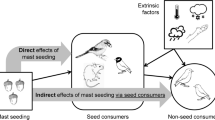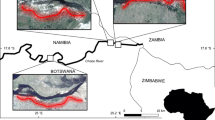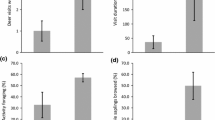Abstract
Large herbivores often have key functions in their ecosystems, and may affect ecosystem processes with cascading effects on other animals. The mechanisms often involve relocations of resources of various kinds, including reduction in resource availability following foraging and increase in resources from animal excreta. As large herbivore populations in Europe generally are intensely managed, management activities may interact with the activities of the herbivores themselves in the effect on other ecosystem components. We investigated the effects of moose (Alces alces) winter browsing, together with the effect of net nutrient input via supplementary winter feeding of moose on functional composition and species richness of birds in a boreal forest. Supplementary feeding stations for moose had a net zero effect on bird species richness and abundance, because negative effects of moose browsing were balanced by positive effects of nutrient input. Sites with a similar browsing intensity as at feeding stations but without nutrient input had lower abundance and species richness than feeding stations. Functional groups of bird species showed differing responses: birds nesting at or below browsing height were negatively affected by moose browsing, whereas species nesting above the browsing zone were positively affected by moose browsing. Insect-eating species responded negatively to moose browsing on birch but positively to nutrient input at feeding stations, whereas seed-eating species responded positively to birch browsing and negatively to feeding stations. This study showed that both high levels of cervid activity and human management interventions influence bird communities.



Similar content being viewed by others
References
Allombert S, Gaston AJ, Martin JL (2005) A natural experiment on the impact of overabundant deer on songbird populations. Biol Conserv 126:1–13
Almendinger J, DNR (2007) A handbook for collecting vegetation plot data in Minnesota: the relevé method. Department of Natural Resources, Minnesota
Bailey JK, Whitham TG (2003) Interactions among elk, aspen, galling sawflies and insectivorous birds. Oikos 101:127–134
Berger J, Stacey PB, Bellis L, Johnson MP (2001) A mammalian predator–prey imbalance: grizzly bear and wolf extinction affect avian neotropical migrants. Ecol Appl 11:947–960
Bergström R, Danell K (1987) Effects of simulated winter browsing by moose on morphology and biomass of 2 birch species. J Ecol 75:533–544
Bibby CJ, Burgess ND, Hill DA, Mustoe SH (2000) Bird census techniques. Academic, London
Bonan GB, Shugart HH (1989) Environmental-factors and ecological processes in boreal forests. Annu Rev Ecol Syst 20:1–28
Burnham KP, Anderson DR (2002) Model selection and multimodel inference: a practical information-theoretic approach. Springer, New York
Casey D, Hein D (1983) Effects of heavy browsing on a bird community in deciduous forest. J Wildl Manag 47:829–836
Cederlund G, Bergström R (1996) Trends in the moose-forest system in Fennoscandia, with special reference to Sweden. In: DeGraaf RM, Miller RI (eds) Conservation of faunal diversity in forested landscapes. Chapman & Hall, London, pp 265–281
Côte SD, Rooney TP, Tremblay JP, Dussault C, Waller DM (2004) Ecological impacts of deer overabundance. Annu Rev Ecol Evol Syst 35:113–147
Cramp S (1977) Handbook of the birds of Europe, the Middle East and North Africa: the birds of the Western Palearctic. Oxford University Press, Oxford
Danell K, Huss-Danell K (1985) Feeding by insects and hares on birches earlier affected by moose browsing. Oikos 44:75–81
Danell K, Haukioja E, HussDanell K (1997) Morphological and chemical responses of mountain birch leaves and shoots to winter browsing along a gradient of plant productivity. Ecoscience 4:296–303
Danell K, Bergstrom R, Edenius L, Ericsson G (2003) Ungulates as drivers of tree population dynamics at module and genet levels. For Ecol Manag 181:67–76
DeCalesta DS (1994) Effect of white-tailed deer on songbirds within managed forests in Pennsylvania. J Wildl Manag 58:711–718
Folkard NFG, Smith JNM (1995) Evidence for bottom up effects in the boreal forest: do passerine birds respond to large scale experimental fertilization? Can J Zool 73:2231–2237
Fuller RJ (2001) Responses of woodland birds to increasing numbers of deer: a review of evidence and mechanisms. Forestry 74:289–298
Graham MH (2003) Confronting multicollinearity in ecological multiple regression. Ecology 84:2809–2815
Gundersen H, Andreassen HP, Storaas T (2004) Supplemental feeding of migratory moose Alces alces: forest damage at two spatial scales. Wildl Biol 10:213–223
Hester AJ, Bergman M, Iason GR, Moen J (2006) Impacts of large herbivores on plant community structure and dynamics. In: Danell K, Bergstrom R, Duncan P, Pastor J (eds) Large herbivore ecology. Ecosystem dynamics and conservation. Cambridge University Press, Cambridge, pp 97–128
Hill MO, Gauch HG (1980) Detrended correspondence analysis—an improved ordination technique. Vegetatio 42:47–58
Hobbs NT (1996) Modification of ecosystems by ungulates. J Wildl Manag 60:695–713
Littell RC (2006) SAS for mixed models. SAS Institute, Cary
Loe LE, Mysterud A, Stien A, Steen H, Evans DM, Austrheim G (2007) Positive short-term effects of sheep grazing on the alpine avifauna. Biol Lett 3:109–111
Luccarini S, Mauri L, Ciuti S, Lamberti P, Apollonio M (2006) Red deer (Cervus elaphus) spatial use in the Italian Alps: home range patterns, seasonal migrations, and effects of snow and winter feeding. Ethol Ecol Evol 18:127–145
Mackey RL, Currie DJ (2001) The diversity–disturbance relationship: is it generally strong and peaked? Ecology 82:3479–3492
Martin JL, Joron M (2003) Nest predation in forest birds: influence of predator type and predator’s habitat quality. Oikos 102:641–653
Mathisen KM, Buhtz F, Danell K, Bergstrom R, Skarpe C, Suominen O, Persson IL (2010) Moose density and habitat productivity affects reproduction, growth and species composition in field layer vegetation. J Veg Sci 21:705–716
McShea WJ, Rappole JH (2000) Managing the abundance and diversity of breeding bird populations through manipulation of deer populations. Conserv Biol 14:1161–1170
McShea WJ, Underwood HB, Rappole JH (1997) The science of overabundance: deer ecology and population management. Smithsonian Institution Press, Washington
Melis C, Sundby M, Andersen R, Moksnes A, Pedersen B, Roskaft E (2007) The role of moose Alces alces L. in boreal forest—the effect on ground beetles (Coleoptera, Carabidae) abundance and diversity. Biodivers Conserv 16:1321–1335
Miyashita T, Takada M, Shimazaki A (2004) Indirect effects of herbivory by deer reduce abundance and species richness of web spiders. Ecoscience 11:74–79
Moen A, Lillethun A, Odland A (1999) Vegetation. Norwegian Mapping Authority, Hønefoss
Neff DJ (1968) The pellet-group count technique for big game trend, census, and distribution: a review. J Wildl Manag 32:597–614
Pastor J, Naiman RJ (1992) Selective foraging and ecosystem processes in boreal forests. Am Nat 139:690–705
Pastor J, Dewey B, Naiman RJ, McInnes PF, Cohen Y (1993) Moose browsing and soil fertility in the boreal forests of Isle-Royale-National-Park. Ecology 74:467–480
Pastor J, Cohen Y, Hobbs NT (2006) The roles of large herbivores in ecosystem nutrient cycles. In: Danell K, Bergstrom R, Duncan P, Pastor J (eds) Large herbivore ecology. Ecosystem dynamics and conservation. Cambridge University Press, Cambridge, pp 289–325
Pedersen S, Nilsen EB, Andreassen HP (2007) Moose winter browsing affects the breeding success of great tits. Ecoscience 14:499–506
Persson IL, Danell K, Bergstrom R (2000) Disturbance by large herbivores in boreal forests with special reference to moose. Ann Zool Fenn 37:251–263
Persson IL, Danell K, Bergstrom R (2005a) Different moose densities and accompanied changes in tree morphology and browse production. Ecol Appl 15:1296–1305
Persson IL, Pastor J, Danell K, Bergstrom R (2005b) Impact of moose population density on the production and composition of litter in boreal forests. Oikos 108:297–306
Persson IL, Bergstrom R, Danell K (2007) Browse biomass production and regrowth capacity after biomass loss in deciduous and coniferous trees: responses to moose browsing along a productivity gradient. Oikos 116:1639–1650
Putman RJ, Staines BW (2004) Supplementary winter feeding of wild red deer Cervus elaphus in Europe and North America: justifications, feeding practice and effectiveness. Mamm Rev 34:285–306
Quinn GP, Keough MJ (2002) Experimental design and data analysis for biologists. Cambridge University Press, Cambridge
Rice ME (2010) Niche preference of a coprophagous scarab beetle (Coleoptera: Scarabaeidae) for summer moose dung in Denali National Park, Alaska. Coleopt Bull 64:148–150
Riipi M, Lempa K, Haukioja E, Ossipov V, Pihlaja K (2005) Effects of simulated winter browsing on mountain birch foliar chemistry and on the performance of insect herbivores. Oikos 111:221–234
Sanz JJ (1998) Effect of habitat and latitude on nestling diet of Pied Flycatchers Ficedula hypoleuca. Ardea 86:81–88
SAS Institute (2003) SAS for Windows ver. 9.1.3. SAS Institute, Cary
Shimazaki A, Miyashita T (2002) Deer browsing reduces leaf damage by herbivorous insects through an induced response of the host plant. Ecol Res 17:527–533
Skarpe C, Hester A (2008) Plant traits, browsing and grazing herbivores, and vegetation dynamics. In: Gordon IJ, Prins HHT (eds) The ecology of browsing and grazing. Springer, Berlin, pp 217–261
Stewart AJA (2001) The impact of deer on lowland woodland invertebrates: a review of the evidence and priorities for future research. Forestry 74:259–270
Stokland JN (1997) Representativeness and efficiency of bird and insect conservation in Norwegian boreal forest reserves. Conserv Biol 11:101–111
Strengbom J, Nordin A (2008) Commercial forest fertilization causes long-term residual effects in ground vegetation of boreal forests. For Ecol Manag 256:2175–2181
Strengbom J, Witzell J, Nordin A, Ericson L (2005) Do multitrophic interactions override N fertilization effects on Operophtera larvae? Oecologia 143:241–250
Suominen O (1999) Impact of cervid browsing and grazing on the terrestrial gastropod fauna in the boreal forests of Fennoscandia. Ecography 22:651–658
Suominen O, Danell K (2006) Effects of large herbivores on other fauna. In: Danell K, Bergstrom R, Duncan P, Pastor J (eds) Large herbivore ecology. Ecosystem dynamics and conservation. Cambridge University Press, Cambridge
Suominen O, Persson I-L, Danell K, Bergström R, Pastor J (2008) Impact of simulated moose densities on abundance and richness of vegetation, herbivorous and predatory arthropods along a productivity gradient. Ecography 31:636–645
ter Braak CJF, Smilauer P (2006) Canoco for Windows ver. 4.54. Biometris, Plant Research, Wageningen
Throop HL, Lerdau MT (2004) Effects of nitrogen deposition on insect herbivory: Implications for community and ecosystem processes. Ecosystems 7:109–133
Torgersen S (2008) Effects of moose density and supplementary feeding on field layer vegetation. Thesis, Department of forestry and wildlife management. Hedmark University College, Evenstad
van Beest FM, Gundersen H, Mathisen KM, Milner JM, Skarpe C (2010) Long-term browsing impact around diversionary feeding stations for moose in Southern Norway. For Ecol Manag 259:1900–1911
Waide RB, Willig MR, Steiner CF, Mittelbach G, Gough L, Dodson SI, Juday GP, Parmenter R (1999) The relationship between productivity and species richness. Annu Rev Ecol Syst 30:257–300
Waldbauer G (1998) The birder’s bug book. Harvard University Press, Cambridge
Weisberg PJ, Bugmann H (2003) Forest dynamics and ungulate herbivory: from leaf to landscape. For Ecol Manag 181:1–12
Acknowledgements
We thank Beate B. Bakke, Marcus Fisher, Christoph Grüner, Lars Hemsing, Christian Jeschke, Henry Stumpf and Roy Ågedal for carrying out fieldwork very early in the morning. Thanks to Kjell Danell, Inga-Lill Persson, Roger Bergström and Jos Milner for reading the manuscript and giving good comments. We are grateful to Harry P. Andreassen and Erlend B. Nilsen for the idea behind this study. We also thank Hedmark University College and the Research Council of Norway for giving financial support to this research.
Author information
Authors and Affiliations
Corresponding author
Appendix: Bird species observations and functional group classification
Appendix: Bird species observations and functional group classification
See Table 4.
About this article
Cite this article
Mathisen, K.M., Skarpe, C. Cascading effects of moose (Alces alces) management on birds. Ecol Res 26, 563–574 (2011). https://doi.org/10.1007/s11284-011-0815-6
Received:
Accepted:
Published:
Issue Date:
DOI: https://doi.org/10.1007/s11284-011-0815-6




